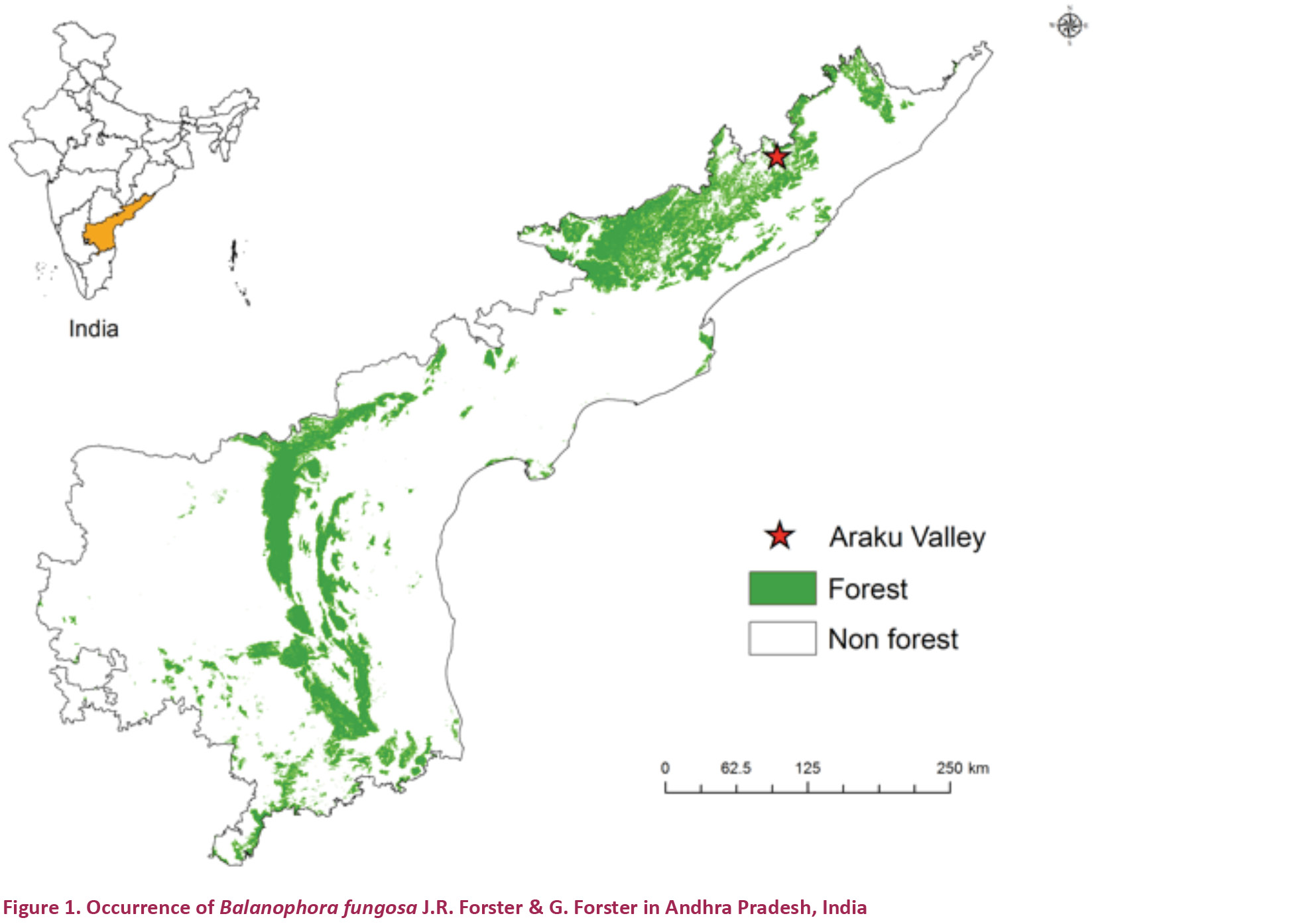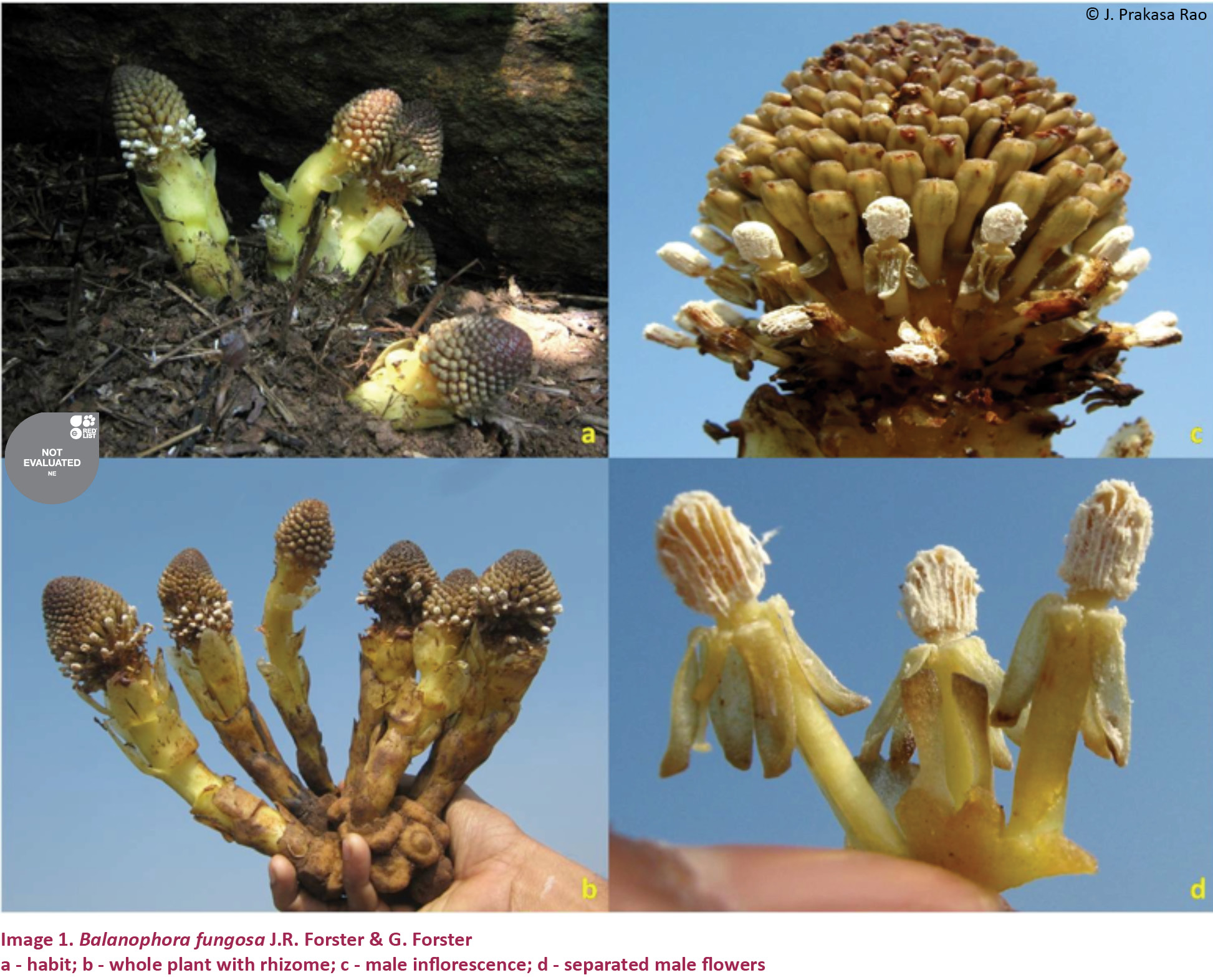On the occurrence of parasitic plant Balanophora fungosa J.R. Forster & G. Forster (Balanophoraceae) in Andhra Pradesh, India
J. Prakasa Rao 1, K.V. Satish 2, B. Siva Sankar 3, C. Sudhakar Reddy 4 & O. Aniel Kumar 5
1,3,5 Department of Botany, Andhra University, Visakhapatnam, Andhra Pradesh 530003, India
2,4 Forestry and Ecology Group, National Remote Sensing Centre, Indian Space Research Organisation, Balanagar, Hyderabad, Telangana 500037, India
1 jprakasarao@gmail.com, 2 kvsflora@gmail.com, 3 bssankar2010@gmail.com, 4 drsudhakarreddy@gmail.com (corresponding author),
5 owkanielkumar@yahoo.com
doi: http://dx.doi.org/10.11609/JoTT.o3962.6943-6
Editor: N.P. Balakrishnan, Retd. Joint Director, BSI, Coimbatore, India. Date of publication: 26 February 2015 (online & print)
Manuscript details: Ms # o3962 | Received 08 March 2014 | Final received 16 December 2014 | Finally accepted 02 February 2015
Citation: Rao, J.P., K.V. Satish, B.S. Sankar, C.S. Reddy & O.A. Kumar (2015). On the occurrence of parasitic plant Balanophora fungosa J.R. Forster & G. Forster (Balanophoraceae) in Andhra Pradesh, India. Journal of Threatened Taxa 7(2): 6943–6946; http://dx.doi.org/10.11609/JoTT.o3962.6943-6
Copyright: © Rao et al. 2015. Creative Commons Attribution 4.0 International License. JoTT allows unrestricted use of this article in any medium, reproduction and distribution by providing adequate credit to the authors and the source of publication.
Funding: Andhra University.
Competing Interest: The authors declare no competing interests.
Acknowledgements: We are grateful to Dr. M.Venkaiah, Department of Botany, Andhra University and Dr. C.S. Jha, Group Head, Forestry and Ecology Group, NRSC for facilities and encouragement.

Araku Valley is a rich biodiversity area in the Eastern Ghats, located in the northern part of Visakhapatnam District of Andhra Pradesh, India (Fig. 1). It consists of a series of hills consisting of Galikonda, Raktakonda, Sunkarimetta and Chitamogondi, and rises to an elevation of above 1000m. The average rainfall is around 1600mm, the bulk of which is received during June–October. Due to high elevation and rainfall, the Araku Valley consists of semi evergreen and moist deciduous forests (Pattanaik et al. 2009).
Balanophora is a genus of root holoparasites, widely distributed in the tropics and subtropics. Balanophora species are known to parasitize about 74 species belonging to 35 families (Mabberley 1987). Three species of Balanophora, namely, B. involucrata, B. polyandra and B. harlandii were reported from the Eastern Himalaya (Chowdhery 1997). Balanophora fungosa J.R. Forster & G. Forster is a root parasitic plant without root and chlorophyll. The distribution of this plant species depends on many factors such as host plants, pollinators, dispersers and moisture. It is being used by the tribal communities for treatment against skin infections and piles (Venkatareddi 1969).

Balanophora fungosa
J.R. Forster & G. Forster Char. Gen. Pl. 50. 1775 (Image 1).
Specimen examined: 21264, 21286AU (B.D.H.), 26.xii.2012, 09.ix.2013, 1100m, Raktakonda (18016’37.8’’N & 82059’49.2’’E), Araku Valley, Visakhapatnam, Andhra Pradesh, India, coll. J. Prakasa Rao & K.V. Satish.
Description: The plants are dioecious. Rhizome yellowish-brown, surface with granular warts and scattered yellow stellate lenticels; branches subglobose, depressed, up to 3cm. Scapes yellowish, up to 30. Leaves alternate, broadly ovate, 1.5×3.2. cm, apex obtuse. Male inflorescences ellipsoid, conically ovoid, up to 6cm; male flowers actinomorphic. Pedicel up to 1.2cm long. Perianth lobes 4 or 5, ovate-elliptic, apex acute. Synandria subglobose, anthers 4 or 5, U-shaped. Pollen white, powdery (Image 1).
Habitat: Rare, near perennial streams of moderately dense semi evergreen forest, at 1100 m altitude.

Flowering & Fruiting: December–April.
Floral associations: Trees: Acer laurinum Hassk., Canthium dicoccum (Gaertn.) Merr., Glochidion ellipticum Wight, Litsea deccanensis Gamble, Litsea glutinosa (Lour.) C.B. Rob., Neolitsea foliolosa A.M. Cowan & Cowan, Garuga pinnata Roxb., Ficus microcarpa L.f; Shrubs and Climbers: Gnetum ula Brongn., Leea asiatica (L.) Ridsdale, Bauhinia vahlii Wight &Arn., Hoya wightii Hook.f., Schefflera stellata (Gaertn.) Baill., Lantana camara (L.); Herbs: Chromolaena odorata (L.) R.M. King & H. Rob., Ageratina adenophora (Spreng.) R.M. King & H. Rob., Triumfetta pilosa Roth, Alocasia decipiens Schott, Costus speciosus (J. Konig) C. Specht, Zingiber roseum (Roxb.) Roseoe; Ferns: Adiantum sp., Cyathea sp.
Distribution in peninsular India: Earlier this species was reported from the Western Ghats of Tamil Nadu (Nilgiris, Palni Hills), Kerala (Travancore), Karnataka (Kodagu) and the Eastern Ghats of Tamil Nadu (Sirumalai Hills,) (Henry et al. 1987; Murthy & Yoganarasimhan 1990; Matthew 1995; Pallithanam 2001). It has not yet been reported from Andhra Pradesh (Ellis 1990; Pullaiah & Moulali 1997; Rao & Kumari 2008; Reddy et al. 2008; Chandra & Azeez 2011). The present distribution from Araku Valley forms an additional distribution record for Andhra Pradesh.
Complexity of the genus Balanophora: Finding the Balanophora itself is enormously difficult in the forest, as it usually forms underground tuberous structure, haustorium attached to the host plants and only becomes known above ground during flowering, although highly reduced and the remnant floral organs are sometimes difficult to construe the ontological organs. Due to modification and reduction in floral morphology it presents an obstacle in determining the evolutionary relationships and appropriate position in the classification of these parasitic angiosperms; and the phenology of Balanophoraceae has been controversial. The host-parasite interactions have special interest for ecologists and physiologists (Datta et al. 2014).
Threat: This species was found with a small population of about 20 individuals along the perennial streams of valleys. Invasion of alien species, i.e., Chromolaena odorata (L.) R.M. King & H. Rob, and Ageratina adenophora (Sprengel) R.M. King & H. Rob. and forest degradation in the environs may cause a survival threat to this species.
Conservation: There is an urgent need to cover Araku Valley under the protected area network of Andhra Pradesh which represents high altitude subtropical ecosystem and gap conservation area. Araku Valley is an ecologically unique region of the Eastern Ghats with representation of several rare and endemic species has to be prioritized for long term conservation management.
References
Chowdhery, H.J. (1997). Plant diversity in Dibang Valley District, Arunachal Pradesh, pp. 99–134 pp. In: Plant Diversity Hotspots in India: An overview. Hajra, P.K. & V. Mudgal (eds.). Botanical Survey of India, Howrah, 113pp.
Ellis, J.L. (1990). Flora of Nallamalais. Botanical Survey of India, Kolkata, 486pp.
Henry, A.N., G.R. Kumari & V. Chithra (1987). Flora of Tamil Nadu, India - Vol. II. Botanical Survey of India, 220pp.
Datta, R.I., A.B. Singh & R.G. Singh (2014). A rare and endangered root parasite: Balanophora involucrata Hook. f. & Thompson. Indian Forester 140(4): 435–436.
Murthy, K.R.K. & S.N. Yoganarasimhan (1990). Flora of Coorg (Kodagu), Karnataka, India. Vimsat Publishers, Bangalore, 393pp.
Mabberley, D.J. (1987). The Plant Book. Cambridge University Press, Cambridge, 73pp.
Matthew, K.M. (1995). An Excursion Flora of Central Tamil Nadu, India. Oxford & IBH Publishing Company, New Delhi, 440pp.
Pallithanam, J.M. (2001). A Pocket Flora of Sirumalai Hills, South India. The Rapinat Herbarium, Tiruchirapalli, 223pp.
Pattanaik, C., S.N. Prasad & C.S. Reddy (2009). Need for urgent conservation of biodiversity in Araku Valley, Andhra Pradesh. Current Science 96(1): 11–12.
Pullaiah, T. & D.A. Moulali (1997). Flora of Andhra Pradesh - Vol. II. Scientific Publishers. Jodhpur, 606pp.
Chandra, R. & P.A. Azeez (2011). The flora of Araku Valley, Visakhapatnam, Andhra Pradesh. Indian. Journal of Economic and Taxonomic Botany 35(4): 816–836.
Reddy, C.S., K.N. Reddy & V.S. Raju (2008). Supplement to Flora of Andhra Pradesh, India. Deep Publications, New Delhi, 148pp.
Rao, G.V.S. & G.R. Kumari (2008). Flora of Visakhapatnam District, Andhra Pradesh - Vol. II. Botanical Survey of India, Ministry of Environment & Forests, Kolkata, 536pp.
Venkatareddi, B. (1969). A new species of Acroblastum (Balanophoraceae) from Poona District, India. Willdenowia 389–393pp.
Key to the species of Balanophora in the Eastern Ghats:
1. Bracts subtending flowers free or few are not developed, bracts rudimentary or not developed; inflorescences ovoid to ellipsoid; flowers actinomorphic with isomorphic perianth lobes ……...................................................................…………. B. fungosa
2. Bracts developed and stout, flowers long pedicellate; anther cells usually U-shaped; perianth lobes ovate, less than 2 mm; synandria hemispheric …………………................................................................................................……………………… B. dioica